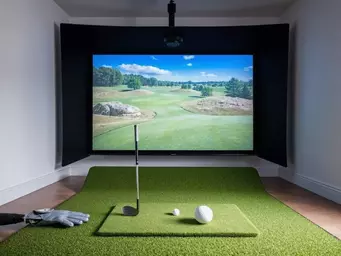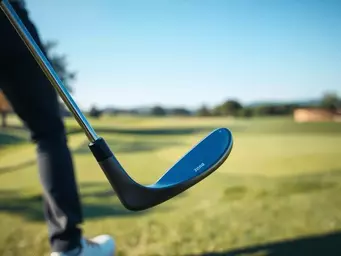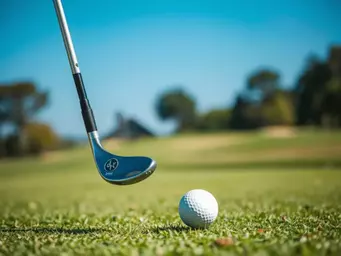Mastering Your Golf Grip Basics

Have you ever considered how the simplest aspects of your game could be the key to unlocking your true potential on the course? The grip of your golf club is one such element that often goes overlooked, yet it serves as the foundation for every swing. Mastering the right grip can lead to significant improvements in your performance, whether you're a novice or a seasoned player.
What You Will Learn
- A proper golf grip is essential for accuracy, consistency, and power in your swing.
- Different grip types—interlocking, overlapping, ten-finger, and neutral—offer unique benefits tailored to various playing styles.
- Grip pressure significantly impacts shot accuracy: finding a balance between tight and loose grips is crucial.
- Avoid common grip mistakes, such as over-tightening and improper club placement, to enhance your control and feel.
- Regular practice with specific drills can reinforce proper grip habits and improve your overall performance.
Key Golf Grip Types and Their Benefits
Having the right golf grip is fundamental for every shot. Here’s a quick overview of the main grip types, their characteristics, and who they are best suited for:
Best for Stability
Interlocking Grip
Description: Pinky of trailing hand interlocks with index finger of lead hand.
Benefits: Provides stability, control over clubface, minimizes wrist movement, comfortable for smaller hands.
Best for Power & Fluidity
Overlapping Grip
Description: Pinky of trailing hand overlaps index finger of lead hand.
Benefits: Facilitates natural swing, generates clubhead speed, allows for relaxed hold, used by pros.
Best for Beginners
Ten-Finger Grip
Description: All ten fingers on the club, like a baseball bat.
Benefits: Easy to learn, generates maximum clubhead speed, builds comfort and confidence for new golfers.
Best for Balance & Consistency
Neutral Grip
Description: Hands work together without excessive rotation, promoting balance.
Benefits: Versatile for various styles, consistent clubface positioning, maintains rhythm throughout the swing.
Understanding the Importance of a Proper Golf Grip
When it comes to playing golf, your grip is more than just how you hold the club—it's the foundation of your entire game. A proper golf grip influences every aspect of your swing. Whether you're a seasoned pro or just starting, understanding its importance can elevate your performance on the course!
The grip is your only connection to the club, and even the smallest adjustments can lead to significant changes in your shots. From consistency to power, let's explore why nailing the right grip is crucial for every golfer.
Why Your Golf Grip Matters for Performance
Your grip directly affects your swing and overall performance. A secure grip allows for better control, leading to more accurate shots. When your grip feels comfortable and confident, you can focus on your technique rather than worrying about mishaps. Here are some key reasons why your grip matters:
- Accuracy: A proper grip helps you control the clubface at impact, leading to straighter shots.
- Consistency: The same grip allows for repeatable swings, giving you confidence in your game.
- Power: A good grip maximizes your swing speed, translating to longer drives.
In essence, the right grip serves as a bridge between your body and the club, making it a crucial element of your golfing toolkit. As you refine your grip, you’ll notice improvements in your overall game!
How a Good Grip Contributes to Swing Mechanics
Understanding how your grip affects swing mechanics can transform your approach to the game. With a proper grip, your hands work in harmony with your body, allowing for a more natural swing. Here's how a solid grip contributes to your swing mechanics:
- Stability: A good grip stabilizes the club, helping you maintain balance throughout your swing.
- Timing: Proper grip pressure influences timing, ensuring your body and club move together.
- Clubface Control: It allows for precise adjustments to the clubface angle, affecting the direction of your shots.
By focusing on your grip, you're not just enhancing your hold—you're setting the stage for a successful swing. Think of it as tuning an instrument; the right grip helps play the perfect melody on the golf course!
Impact of Grip Pressure on Shot Accuracy
Grip pressure is often overlooked but plays a pivotal role in shot accuracy. Too tight, and you risk losing feel; too loose, and you might lose control. Striking the right balance is key!
- Light Grip: Promotes feel and touch, ideal for short game shots.
- Medium Grip: Provides a balance between control and comfort for most swings.
- Tight Grip: Can lead to tension and inconsistency, especially in longer shots.
As you practice, pay attention to how grip pressure affects your shots. Finding that sweet spot can significantly improve your accuracy, leading to lower scores and a more enjoyable round!
Exploring Different Types of Golf Grips
Now that we understand the importance of a proper grip, let's delve into the different types of grips that golfers use. Each grip has its unique benefits, and choosing the right one can enhance your performance. Here’s a closer look:
Interlocking Grip: When and How to Use It
The interlocking grip is popular among golfers with smaller hands. It involves interlocking the pinky finger of the trailing hand with the index finger of the lead hand. This grip provides stability and connection, essential for a reliable swing.
Benefits of the Interlocking Grip for Stability
This grip style offers several advantages:
- Control: Provides greater control over the clubface at impact.
- Stability: Helps minimize wrist movement during the swing.
- Comfort: Great option for players with smaller hands or less grip strength.
Using the interlocking grip can create a firmer connection with the club, leading to enhanced performance, especially in challenging conditions!
Overlapping Grip: Advantages and Techniques
The overlapping grip, also known as the Vardon grip, is widely used by professional golfers. It involves overlapping the pinky of the trailing hand over the index finger of the lead hand, creating a solid connection and allowing for more fluid swings.
How the Overlapping Grip Affects Swing Dynamics
This grip style can enhance your swing in several ways:
- Fluidity: Facilitates a more natural swing motion.
- Power: Can help generate additional clubhead speed.
- Comfort: Allows for a relaxed hold, reducing tension.
By mastering the overlapping grip, you can experience a seamless integration of your hands and body during your swing!
Ten-Finger Grip: Ideal for Beginners
The ten-finger grip, or baseball grip, is straightforward and suitable for beginners. All ten fingers are on the club, making it a comfortable option for those new to the game.
How the Ten-Finger Grip Affects Swing Dynamics
This grip offers unique benefits, especially for novice players:
- Easy to Learn: Simplifies the learning process for new golfers.
- Powerful: Generates maximum clubhead speed due to the full grip.
- Confidence: Builds comfort and confidence in your hold.
If you’re just starting, the ten-finger grip can help you get a feel for your shots without overcomplicating your grip mechanics!
Neutral Grip: Finding Balance in Your Hold
The neutral grip is often recommended for golfers seeking a balance between power and precision. This grip allows the hands to work together without excessive rotation, fostering more reliable swings.
Adapting the Neutral Grip for Different Playing Styles
Here are some key features of the neutral grip:
- Versatility: Suitable for various playing styles and swing paths.
- Consistency: Promotes consistent clubface positioning at impact.
- Balance: Helps maintain balance and rhythm throughout the swing.
As you refine your grip, consider how a neutral grip can enhance your overall performance, allowing for greater adaptability on the course!
Pro Tip
To truly enhance your golf grip, consider incorporating grip strength exercises into your routine. Simple activities like squeezing a stress ball or using grip trainers can significantly improve your control and feel, leading to better performance on the course.
FAQs About Golf Grips
Summarizing Key Takeaways on Golf Grip Techniques
As we wrap up our discussion on golf grip techniques, it's crucial to remember that your grip is the foundation of every shot. Each grip type we explored offers unique benefits that can enhance your performance on the course. Here’s a quick recap:
- Interlocking Grip: Great for stability and control, especially for players with smaller hands.
- Overlapping Grip: Provides a solid hold for stronger players, allowing for more power in your swing.
- Ten-Finger Grip: Ideal for beginners, promoting simplicity and comfort.
- Neutral Grip: Versatile, allowing players to adjust their hold based on playing style.
By understanding these grip types, you can choose the one that best suits your individual needs. Each grip not only affects your swing mechanics but also your overall confidence on the course!
Final Thoughts on Avoiding Common Grip Mistakes
While mastering grip techniques, it’s just as important to avoid common mistakes that can hinder your performance. One prevalent issue is over-tightening your grip, which can lead to tension and inconsistency. As Keiser University's College of Golf highlights, your grip is the primary point of contact with the club, and a proper hold is essential for an effective swing. Remember, a relaxed hold can lead to better control and a smoother swing.
Additionally, holding the club in your palms instead of your fingers can diminish your feel and feedback from the club. Focus on positioning the club in your fingers to enhance your touch and responsiveness. Golf.com provides excellent insights into grip fundamentals, emphasizing the importance of proper hand placement for better control and consistency.
- Stay conscious of grip pressure—aim for a light hold.
- Ensure the club fits your hand size; this will improve comfort and control.
- Practice regularly to reinforce proper grip habits.
By being mindful of these common pitfalls, you can significantly enhance your game and enjoy your time on the course even more. Remember, practice makes perfect, and adjusting your grip could be the game-changing factor you’ve been looking for!
Taking the Next Steps to Improve Your Golf Grip
Actionable Tips for Practicing Your Grip
Now that you have a solid understanding of different grips and their benefits, let’s discuss some actionable tips to help you practice effectively. Start by dedicating specific time during your practice sessions to focus solely on your grip. This will help reinforce good habits and enhance muscle memory.
- Set up a mirror or use video to assess your grip position.
- Try different grip types during practice to find what works best for you.
- Incorporate grip exercises into your routine, such as squeezing a stress ball.
These exercises can help improve grip strength and dexterity, which are vital for achieving a steady and effective swing.
Practice Drills for Enhancing Grip Consistency
Consistency in your grip is key to better performance. Here are some drills to help enhance that consistency:
- Grip Check Drill: Pause after each shot to reassess your grip and ensure it feels right.
- One-Handed Drills: Practice swings with just your left and then right hand to develop feel and strength in each grip.
- Grip Pressure Drill: Alternate between light and firm grips during your practice swings to find the right balance.
Incorporating these drills into your routine can make a huge difference in your overall game. As you build consistency, you’ll likely see improved shot accuracy and confidence!
Resources for Further Learning on Golf Grip Techniques
To continue your journey toward mastering your golf grip, consider exploring additional resources that dive deeper into grip techniques. For instance, research on golf grip kinematics can provide a scientific perspective on how different grips affect your swing. Online video tutorials can be particularly effective, as they provide visual demonstrations of proper grip techniques and adjustments.
- Visit reputable golf websites like iGolf Magazine for expert articles and tips.
- Follow professional golfers on social media for insights and personal grip strategies.
- Consider taking a lesson with a professional coach who can provide personalized feedback on your grip.
By using these resources, you’ll be well on your way to refining your grip and enhancing your overall golf game. Remember, the grip is just the beginning—each swing is a chance to grow and enjoy the sport!
Recap of Key Points
Here is a quick recap of the important points discussed in the article:
- Importance of Grip: A proper golf grip is essential for accuracy, consistency, and power in your shots.
- Grip Pressure: Finding the right balance in grip pressure can enhance shot accuracy and control.
- Types of Grips: Understanding the interlocking, overlapping, ten-finger, and neutral grips can help golfers select the best style for their game.
- Avoiding Mistakes: Maintaining a relaxed grip and positioning the club in your fingers are crucial for optimal performance.
- Practice Techniques: Incorporating grip practice drills can significantly improve consistency and muscle memory.








